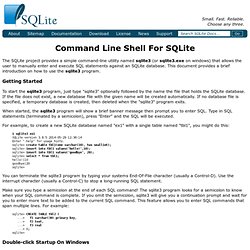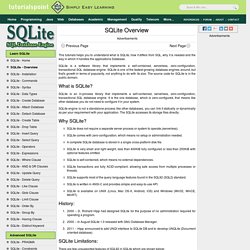

SQLite Query Language: BEGIN TRANSACTION. Small.

Fast. Reliable.Choose any three. [Top] begin-stmt: commit-stmt: rollback-stmt: No changes can be made to the database except within a transaction. Transactions can be started manually using the BEGIN command. END TRANSACTION is an alias for COMMIT. Transactions created using BEGIN...COMMIT do not nest. Transactions can be deferred, immediate, or exclusive.
An implicit transaction (a transaction that is started automatically, not a transaction started by BEGIN) is committed automatically when the last active statement finishes. The explicit COMMIT command runs immediately, even if there are pending SELECT statements. An attempt to execute COMMIT might also result in an SQLITE_BUSY return code if an another thread or process has a shared lock on the database that prevented the database from being updated. In older versions of SQLite the ROLLBACK will fail with an error code SQLITE_BUSY if there are any pending queries. Response To Errors Within A Transaction. Command Line Shell For SQLite. Small.

Fast. Reliable.Choose any three. The SQLite project provides a simple command-line utility named sqlite3 (or sqlite3.exe on windows) that allows the user to manually enter and execute SQL statements against an SQLite database. This document provides a brief introduction on how to use the sqlite3 program. Getting Started To start the sqlite3 program, just type "sqlite3" optionally followed by the name the file that holds the SQLite database. When started, the sqlite3 program will show a brief banner message then prompt you to enter SQL. For example, to create a new SQLite database named "ex1" with a single table named "tbl1", you might do this: $ sqlite3 ex1 SQLite version 3.8.5 2014-05-29 12:36:14 Enter ".help" for usage hints. sqlite> create table tbl1(one varchar(10), two smallint); sqlite> insert into tbl1 values('hello!
' You can terminate the sqlite3 program by typing your systems End-Of-File character (usually a Control-D). Double-click Startup On Windows. 15 SQLite3 SQL Commands Explained with Examples. SQLite3 is very lightweight SQL database which focuses on simplicity more than anything else.

This is a self-contained serverless database engine, which is very simple to install and use. While most of the commands in the SQLite are similar to SQL commands of other datbases like MySQL and ORACLE, there are some SQLite SQL commands that are different. This article explains all the basic SQL commands that you need to know to use the SQLite database effectively. If you don’t have sqlite installed, execute “yum install sqlite” to install it. You can also install SQLite database from source to get the latest version. 1. First, let us understand how create a SQLite database with couple of tables, populate some data, and view those records. The following example creates a database called employee.db. Note: To exit from the SQLite commandline “sqlite>” prompt, type “.quit” as shown above. A SQLite database is nothing but a file that gets created under your current directory as shown below. Sqlite3(1) Mac OS X Manual Page.
SQLite Overview. This tutorials helps you to understand what is SQLite, how it differs from SQL, why it is needed and the way in which it handles the applications Database.

SQLite is a software library that implements a self-contained, serverless, zero-configuration, transactional SQL database engine. SQLite is one of the fastest-growing database engines around, but that's growth in terms of popularity, not anything to do with its size. The source code for SQLite is in the public domain. What is SQLite? SQLite is an in-process library that implements a self-contained, serverless, zero-configuration, transactional SQL database engine.
SQLite engine is not a standalone process like other databases, you can link it statically or dynamically as per your requirement with your application. Why SQLite? SQLite does not require a separate server process or system to operate. History: 2000 -- D. SQLite Limitations: There are few unsupported features of SQL92 in SQLite which are shown below: Sqlite_tutorial.pdf.